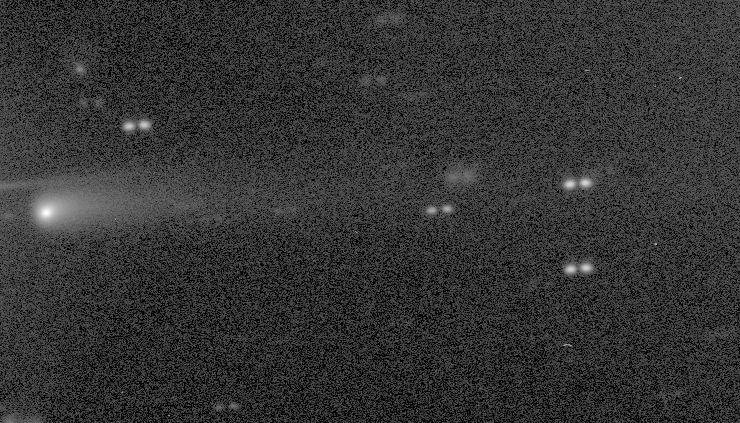Astronomers using ESO’s ground-based Very Large Telescope (VLT) in Chile are watching the development of Comet 67P/Churyumov-Gerasimenko’s coma and tail from Earth. This image is based on data acquired on 22 May and is about 300 000 km wide at the distance of the comet.

Comet 67P/C-G on 22 May taken with the VLT/FORS2 instrument. It is a combination of 2 x 30s R-band exposures, aligned on the comet. The comet moved against the background stars between the two images, leading to double stars in this combination. Credits: Colin Snodgrass / Alan Fitzsimmons / ESO
The comet’s dusty coma and tail is swept away from the Sun, which is towards the left of the image in this orientation. The tail can be seen to stretch at least 120 000 km in this relatively shallow image, and in deeper images, the coma alone is estimated to be at least 80–100 000 km across.
As each pixel in this image spans roughly 400 km at the comet, both Rosetta and the nucleus of 67P/C-G are too small to be resolved. But images like these provide important context information for the images taken by the spacecraft close to the comet, as its activity increases towards perihelion.
At the time the image was taken Rosetta and the comet were about 238 million km from the Sun; at perihelion on 13 August they will be between the orbits of Earth and Mars at a distance of about 186 million km from the Sun.
This image will be shown as part of the BBC Sky at Night TV programme in the UK on Sunday 14 June. The episode is a Rosetta special and includes interviews with a number of scientists discussing what we have learned about Comet 67P/C-G so far.









Discussion: 11 comments
We finally get to see an image of the comet taken from Earth. I’ve been waiting patiently for this!
At perihelion the comet will only be about 22% closer to the sun than it is now. Am I right in thinking that there should be much more than 22% increase in activity at that time due to the inverse square law as it relates to the solar ‘wind’?
Emily, do you know how much closer the comet will be to Earth at perihelion? I’m wondering how much more detail will be will be detected at that time from Earth…
Is there a graphic available that shows the comet, the sun and Earth at the time of perihelion?
Comment vanished!
There is a second effect, the very rapid increase in the vapour pressure of the subliming ice,macaroon dioxide etc with temperature. Small temperature increases cause large pressure increases. Data for ice here:
https://www.kayelaby.npl.co.uk/chemistry/3_4/3_4_1.html
The ice etc has remained well hidden under a layer of surface ‘muck’. However there is currently no other remotely scientifically viable explanation for the observed water and carbon dioxide etc,
As I posted a couple of months ago,m here is a 2003 image from the ESO:
https://univ.smugmug.com/Rosetta-Philae-Mission/EarthBased-Observations/i-ngHnGhX/0/L/CG-coma-scale2–apr-2003–ESO-VLT–enh–neg-L.jpg
Note that in these images there is an asymmetrical and a cross-wise component in the shape of the coma, which suggests that the Polar Dust jets were active at that time.
I am looking forward to a set of really deep images of the coma, which should tie in well with the Rosetta images of the dust jet activity.
–Bill
Bill, could you explain the ‘cross wise…..’ Comment a bit more? I’m not sure what you are referring to.
Intuitively I would have thought that deep into the coma the integrated effects of radiation pressure on the dust, and magnetic field effects on the ion tails would considerably dominate the ‘injection’ effects, whose velocities are not all that high. However I’ve *not* done any sums and that intuition may be wrong.
Further explanation would be welcome.
I am asking myself this: rosetta is introducing some minute pollution into this coma.
All this 100000s km wide thing is very low density.
Is there something you folks could look at to find that the contents of this coma is ever so slightly altered by the presence of Rosetta and the lander?
Some fuel molecules, or sputtered off metals off the surface of the devices.
Would be very interesting to know, and to see how sensitive the measurements are.
The amounts of material sputtered off Rosetta would be far, far too small to detect. The thrusters are actually very small, and the products of their combustion identical to materials present in the comet’s coma anyway. So I don’t think there is any possibility at all the minute ‘pollution’ caused by Rosetta is detectable.
>> The comet moved against the background stars between the two images, leading to double stars in this combination. <<
So, what is the single object in the upper left-hand corner of the picture? It appears to be moving almost in tandem with the comet!
That’s a very good question!
The other possible explanation would be a fast moving. object that’s in one frame but not the other.
An (Earth) satellite for example? But the chances of that would be pretty tiny.
A question for the team.
Well spotted! It’s a background asteroid, moving at almost the same apparent rate as the comet, as seen from Earth.
Alan. It would seem extraordinarily improbable for an asteroid that just happens to appear to be close to 67P to have the same apparent motion. Is there some systematic reason for that, or is it really pure chance?
Pure chance. It’s not improbable to see an asteroid when you’re looking near the plane of the Solar System with an 8-m telescope – we see quite a few.
And not the same motion – the asteroid was moving at 17.3 arcsec/hour relative to the comet. These images were combined over 123 seconds, in which time the asteroid moved 0.6 arc seconds relative to 67P.